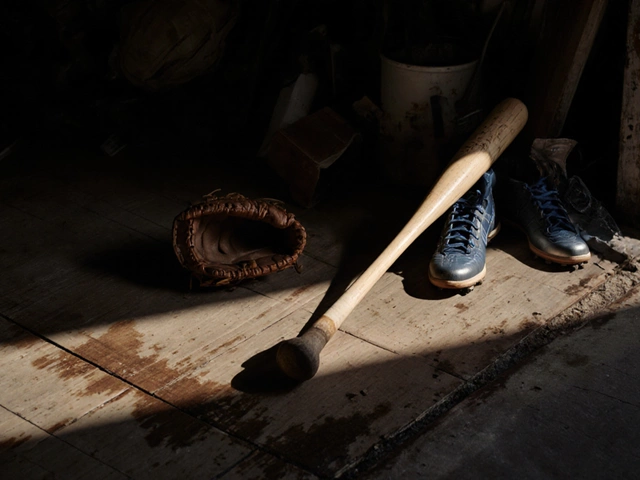Sports Equipment Weapon Potential Comparison Tool
Compare the real-world weapon potential of common sports equipment based on police data, physical properties, and accessibility.
This tool compares equipment based on real-world assault data, physical properties, and accessibility. All data is derived from police reports and crime statistics.
People don’t buy a baseball bat to fight. They buy it to hit a ball. But when tempers flare or situations turn dangerous, everyday sports gear can become something else entirely. The line between equipment and weapon isn’t always clear-and it’s not just in movies. Real people, in real situations, have used sports gear as weapons. And it’s not just bats and sticks. From golf clubs to hockey sticks, many items designed for play can cause serious harm when used the wrong way.
Baseball bats: The most common choice
Baseball bats are lightweight, easy to swing, and pack a lot of force. A standard aluminum bat weighs about 30 ounces. When swung with even moderate speed, it can deliver over 1,000 pounds of force at impact. That’s enough to fracture skulls, break ribs, or cause internal bleeding. Police reports from cities like Chicago and Los Angeles show baseball bats are among the top three sports-related weapons used in assaults. They’re not flashy, but they’re effective. And because they’re so common in garages and backyards, they’re often the first thing someone grabs in a moment of rage.
Hockey sticks: Long reach, brutal impact
Hockey sticks are built to take abuse-slap shots, checks, and crashes on ice. That same durability makes them dangerous on the street. A wooden stick can snap under pressure, but composite sticks? They’re designed to flex and rebound. That means when swung, they don’t just hit-they whip. In 2023, a fight outside a bar in Toronto ended with one man hospitalized after being struck multiple times with a hockey stick. The injuries included a broken jaw and a fractured orbital bone. The stick’s length gives the user distance, and the curved blade can hook or jab. It’s not just a club-it’s a multi-tool for violence.
Cricket bats: Heavy, solid, and deadly
Cricket bats are heavier than baseball bats, often weighing between 2.5 and 3.5 pounds. Made from willow wood with a thick spine, they’re built to drive the ball 100 yards. That same mass makes them devastating in a close-range attack. In the UK, court records from 2022 showed three separate cases where cricket bats were used in fatal assaults. One victim died from a single blow to the temple. The bat’s flat face delivers blunt force trauma. The edge can cut. And because cricket is played in parks and schools, these bats are widely available. No one thinks of them as weapons-until they are.
Tennis rackets: Surprisingly dangerous
Most people assume a tennis racket is harmless. It’s light, stringy, and meant for finesse. But modern rackets are made from carbon fiber and titanium. They’re stiffer and stronger than ever. In 2021, a man in Melbourne used a tennis racket to strike another person during a dispute at a public court. The impact fractured the victim’s skull. The racket didn’t break. It didn’t even bend. It transferred the full force of the swing directly into bone. Even without strings, a racket frame can cause serious injury. And because it’s easy to conceal under a jacket, it’s been used in surprise attacks.

Golf clubs: Quiet, classy, and lethal
Golf clubs are designed for precision, not power. But a driver or iron? They’re heavy metal on a long shaft. A 460cc driver weighs about 320 grams. Add a 45-inch shaft, and you’ve got a 2.5-foot weapon with a dense striking surface. In 2024, a golf course incident in Florida ended with one man in intensive care after being struck with a driver. The clubhead fractured his skull. The shaft split his collarbone. Golfers often carry clubs in bags, not thinking about safety. But in a heated argument, a club can be pulled out faster than you’d expect. And because golf is seen as a polite sport, people lower their guard. That’s when the danger hits.
Other equipment: The unexpected threats
It’s not just the obvious ones. Cricket pads? Heavy plastic and foam-useful for blocking, but if thrown with force, they can knock someone down. A lacrosse stick? The net can entangle, and the shaft can crack skulls. Even a dumbbell can be used as a blunt weapon. In 2023, a gym fight in Seattle ended when one man swung a 25-pound kettlebell. The victim suffered a traumatic brain injury. And let’s not forget the humble jump rope. It’s flexible, easy to swing, and can tighten around a neck. Police in New York have documented cases where jump ropes were used in strangulation attempts.
Why does this happen?
It’s not about malice. It’s about availability and perception. People don’t think of sports gear as weapons because they’re not designed to be. They’re labeled as ‘equipment,’ stored in garages, carried to parks, used in training. That normalcy hides the risk. Add alcohol, anger, or a moment of panic-and the object’s purpose changes instantly. No one plans to turn a tennis racket into a weapon. But in the heat of the moment, it becomes the easiest thing to grab.

What can be done?
There’s no law against owning a baseball bat. And there shouldn’t be. But awareness helps. Coaches, parents, and sports clubs can talk about safety-not just physical safety during play, but the potential for misuse. Store equipment securely. Don’t leave bats or sticks in cars or unlocked sheds. Teach kids that sports gear isn’t a toy to swing at people. And if you’re in a volatile situation, walk away. No trophy, no game, no score is worth a life.
It’s not about banning gear. It’s about understanding it.
Sports equipment is meant to build skill, fitness, and community. It’s not meant to hurt. But when people forget that, the consequences are real. A hockey stick doesn’t turn evil. A golf club doesn’t become violent. It’s the person behind it. And that’s the only thing we can truly control.
Can a tennis racket really break a skull?
Yes. Modern tennis rackets are made from carbon fiber and composite materials that are rigid and strong. In 2021, a case in Melbourne confirmed a skull fracture from a single swing. The racket didn’t shatter-it transferred the full force of the impact. Even without strings, the frame is dense enough to cause serious trauma.
Are there laws against carrying sports equipment as weapons?
Laws vary by location, but in most places, carrying sports equipment with intent to use it as a weapon is illegal. It doesn’t matter if it’s a baseball bat or a golf club-if you’re using it to threaten or harm someone, you can be charged with assault with a deadly weapon. Courts look at context: where you were, what you were doing, and whether you had a legitimate reason to carry it.
Why aren’t sports equipment banned from public spaces?
Because banning them would punish innocent users. Millions of people use baseball bats, hockey sticks, and golf clubs for legitimate reasons every day. Laws target behavior, not objects. It’s illegal to swing a bat at someone-not to own one. The goal is to change how people act, not to take away tools of sport.
Which sports equipment is most commonly used in crimes?
Based on police data from 2020-2024, baseball bats are the most frequently reported, followed by hockey sticks and cricket bats. Golf clubs and tennis rackets appear less often but still cause serious injuries. The reason? Availability and ease of access. Bats are common in homes, while sticks are carried to games and practices.
Can a jump rope be used as a weapon?
Yes. A weighted jump rope, especially one with plastic or metal handles, can be swung like a flail. In 2022, a case in New York involved a woman using a jump rope to strangle another person during an argument. The rope tightened around the neck, causing unconsciousness. Even a standard rope can be used to trip or bind someone. It’s not common, but it’s possible.
Final thought: Respect the tool, not fear it
There’s nothing wrong with owning a cricket bat or a hockey stick. The problem isn’t the gear-it’s the mindset. People who use sports equipment as weapons aren’t bad because they own a bat. They’re bad because they choose to hurt others. The best defense isn’t locking things away. It’s teaching responsibility. Knowing that what you use to play can also be used to harm-that’s the real lesson.






